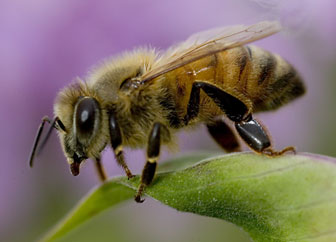Billions of disappearing bees linked to virus
Disappearing bees linked to virus
mongabay.com
September 6, 2007
Scientists have linked the disappearance of tens of billions of bees to a virus, reports a study published in the 7 September issue of the journal Science.
Colony collapse disorder (CCD), in which colonies inexplicably lose all of their worker bees, has been blamed for the loss of 50-90 percent of colonies in beekeeping operations across the U.S.
Sequencing DNA and RNA samples extracted from collapsing and healthy bee colonies, a team of researchers identified five major bacterial groups, four lineages of fungi and seven types of viruses that could be responsible for dying colonies. Of these potential pathogens, only one virus, Israeli Acute paralysis Paralysis Virus (IAPV), was found only in the collapsed colonies.

A honeybee settles onto a wildflower at Fermilab. Image courtesy of the Fermi National Accelerator Laboratory |
“Although we have not proven a causal relationship between infection and CCD, the prevalence of viral sequences in CCD operations… make IAPV a leading candidate,” write the authors
IAPV, a virus not previously reported in the U.S., is transmitted by the varroa mite. Experts have long suspected that bee mites may have a role in the current outbreak of CCD.
The finding could be critical to help scientists address the disorder which has killed some 2.4 million bee colonies across the United States. Bees play an important role in world food supplies, pollinating more than 90 fruit and vegetable crops worldwide. In the United States alone these pollination services are estimated to be worth $14.6 billion annually.
“This discovery may be helpful in identifying hives at risk for disease. The next step is to ascertain whether IAPV, alone or in concert with other factors, can induce CCD in healthy bees,” said Dr. Ian Lipkin of Columbia University.
Reports of Colony Collapse Disorder (CCD) have been documented back to the late 19th century but the current episode is one of the worst ever recorded.
NOTE: Researchers used genetic technologies from 454 Life Sciences, a biotech firm, to survey the microflora of bee hives.
Diana L. Cox-Foster, Sean Conlan, Edward C. Holmes,, Gustavo Palacios, Jay D. Evans, Nancy A. Moran, Phenix-Lan Quan, Thomas Briese, Mady Hornig, David M. Geiser, Vince Martinson, Dennis vanEngelsdorp,, Abby L. Kalkstein, Andrew Drysdale, Jeffrey Hui, Junhui Zhai, Liwang Cui, Stephen K. Hutchison, Jan Fredrik Simons, Michael Egholm, Jeffery S. Pettis, W. Ian Lipkin (2007). Sciencexpress.org 6 September 2007/ Page 1 / 10.1126/science.1146498














